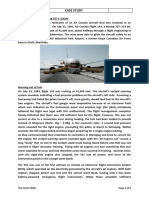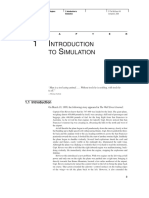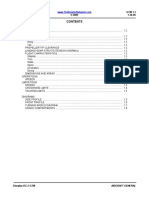Meas Ec
Meas Ec
Uploaded by
Victoria Eugenia PerezCopyright:
Available Formats
Meas Ec
Meas Ec
Uploaded by
Victoria Eugenia PerezOriginal Title
Copyright
Available Formats
Share this document
Did you find this document useful?
Is this content inappropriate?
Copyright:
Available Formats
Meas Ec
Meas Ec
Uploaded by
Victoria Eugenia PerezCopyright:
Available Formats
Name ____________________________________ Period ________ Date __________
EXTRA CREDIT: Dimensional Analysis
and The Crash of Flight 143
This assignment is worth 5 bonus points on your Measurement Test.
Read the accompanying article “The Crash of Flight 143,” ChemMatters, October, 1996, pp. 12-15.
Answer the following questions completely.
1. What are the three possible causes of the 767’s fuel pump alarm?
1)
2)
3)
2. The second fuel pump alarm made which possible cause most likely?
3. The faulty calculation occurred when converting from liters to kilograms. Why isn’t jet fuel
measured by volume like gasoline is in cars?
4. What units were needed on the number 1.77 to express the density of jet fuel?
5. What units should they have used in order to make the correct conversion?
6. How did their calculation error affect the amount of fuel that was pumped into the plane?
7. Explain how using dimensional analysis could have prevented this crash.
8. Calculate the volume of fuel needed for a flight if jet fuel has a density of 0.803 kg/L. First, use
dimensional analysis to convert liters to kilograms. Then, subtract to find how many kilograms need
to be added. Then, use dimensional analysis to convert this mass into liters. For full credit, you
must show your work, include units, and round off each answer to the correct number of sig figs.
Volume on board 8,550. L
Mass on board
Mass required for flight 23,800. kg
Mass to be added
Volume to be added
Extra Credit – Dimensional Analysis
M Y S T E R Y M A T T E R S
I
by Peter Banks
t was a smooth flight as Air Canada 143 made its way from
Montreal to Edmonton on the afternoon of July 23, 1983.
Below were cottony clouds, ahead only blue sky and clear
air. The Boeing 767 cruised at 469 knots, nearing a route check-
point at Red Lake, Ontario.
12 CHEM MATTERS, OCTOBER 1996
In the cockpit, Captain Robert Pearson chatted amiably with his The pilots set the flaps for the single-engine landing, hoping in
first officer, Maurice Quintal. The two men were among only a hand- spite of what they were witnessing that enough fuel remained. But as
ful of pilots trained to fly the twin-engine 767, then they passed 26,000 feet, the remaining engine stopped.
the most advanced jetliner in the The cockpit became quiet. The com-
world. “Everything’s straightfor- puter screens flickered off. Without
ward once you learn it,” Pearson The confusion of the preflight power, the high-tech displays were
told Quintal, nodding toward the dark and useless.
plane’s sophisticated instrument
calculations seemed to slip away One hundred miles from Win-
panel. The 767 had indeed sim- as the huge aircraft raced nipeg, the massive jetliner was left with
plified a pilot’s life. Computer no electronic instruments and with
screens replaced dozens of toward Red Lake. fewer controls than a small single-
instruments. The easy-to-read engine plane. The world’s most
displays reduced pilot fatigue on long flights. On this advanced aircraft was now a glider.
four-hour trip to Edmonton, Pearson expected to relax a bit as he The unthinkable had happened: Flight 143 had run out of fuel.
carried his 61 passengers to western Canada.
But his calm was broken suddenly as the plane passed over Red * * * *
Lake. A warning buzzer gave four quick beeps, and an amber light
H
ow? How does a modern jetliner—equipped with the latest tech-
flashed. nology and piloted by skilled people—run out of fuel at 26,000
Quintal glanced at the indicators in front of him. “Something’s feet? As with most air disasters, there was no single cause.
wrong with the fuel pump.” Flight 143 was brought down by a string of errors in technology,
“Left forward fuel pump,” Pearson added. “I hope it’s just the communication, and training, but at the heart of the crisis was a sim-
fuel pump failing, I’ll tell you that.” ple mistake in calculating the amount of fuel needed for the flight.
The 767 has three fuel tanks, one in each wing and PHOTO BY AP/WIDE WORLD PHOTOS
one in the plane’s belly. For each tank, two pumps deliver
a steady stream of fuel to the engines. The warning told
Pearson and Quintal that the forward pump in the left
wing was not working. This could mean that the pump
had failed, a fuel line was clogged, or that the left tank
was running dry—although the fuel load had been
checked and rechecked before takeoff.
Pearson consulted the plane’s reference handbook,
which said that normal flight was possible with one
defective fuel pump. A few seconds of wary calm passed.
Then more alarms sounded. The second pump in the left
wing tank was also failing. It was too much of a coinci-
dence for two pumps to fail at the same time—it was
more likely that the left tank was running out of fuel.
“We’ve got to go to Winnipeg,” Pearson said quickly,
setting a course for the nearest large airport. Quintal
radioed air traffic control, and they received immediate
clearance to descend to 6,000 feet.
Pearson throttled back the engines and switched a
computer monitor to display the descent into Winnipeg.
But he began to doubt that the plane could even make it
After both engines ran out of fuel, Flight 143 glided powerless for 29 minutes before the pilots
there. brought it down on the end of runway 32. With a collapsed nose gear and two blown tires, the
The cockpit crew grew tense as the 767 nosed down plane skidded to a stop just before hitting a telephone pole and a fence. The giant aircraft
miraculously avoided skidding into people who were watching a sports car race on the
toward the clouds below. More beeps blared the worst abandoned runway.
possible news: all four remaining fuel pumps were now
failing. Pearson maneuvered the aircraft gently, trying to preserve The plane’s instruments should have quickly detected the error.
every trace of fuel. Then the left engine stopped running. The 767 boasts an advanced fuel quantity processor that accurately
gauges fuel on board. But, on this particular plane, the fuel computer
Quintal radioed Winnipeg. “We’ve lost our number one engine.”
had never worked properly, and maintenance workers lacked a spare
Preparing for a possible crash landing, he added, “We’ll require all
computer.
the trucks out.”
CHEM MATTERS, OCTOBER 1996 13
Because the 767 was with the Canadian govern-
a new addition to Air ment’s plan to introduce
Canada’s fleet, the written The pilots and air traffic controllers metric units nationwide.
maintenance standards
were still being revised.
made some hasty calculations and Secondly, the drip proce-
dure told the pilots the
When the ground crew reached a grim conclusion— amount of fuel on board
was preparing the plane
for departure from Mon-
without engines the craft would land not in pounds or kilo-
grams, but in liters.
treal, they found that the 10 miles short of the airport. What’s more, on the
fuel gauge did not work. A earlier airplanes, the fuel
maintenance worker had been calculated not by
assured Pearson—incorrectly—that the plane was certified to fly the pilot or copilot, but by the third person in the cockpit, the flight
without a functioning fuel gauge if the crew manually checked the engineer. The 767 did not carry a flight engineer because the com-
quantity of fuel in the tanks. puters had reduced the cockpit workload. Now, it was unclear
The manual procedure, known as a “drip,” is as old as flying whether the ground crew or the pilots were primarily responsible for
itself. Each fuel tank contains a drip stick, which is similar to the dip the fuel calculations.
stick used to check the oil in a car, except that it is mounted upside Ouellet and Bourbeau knew that the flight to Edmonton, which
down. When a mechanic under the wing loosens the drip stick, it called for a brief stop in Ottawa without refueling, required 22,300
falls within the tank until a float at its tip bobs on the surface of the kilograms (kg) of fuel. Thus they faced this problem: If 7,682 L of
fuel. The mechanic reads the depth of the fuel from markings on the fuel remained in the plane, how many liters had to be added to make
drip stick, then consults a handbook that gives the corresponding a total of 22,300 kg? First Officer Quintal offered to help the mechan-
volume of fuel in the tank. ics solve the problem. “The number of liters times the weight of a
Two Air Canada mechanics, Jean Ouellet and Rodrigue liter will give you kilograms, right?” Quintal turned to a mechanic in
Bourbeau, had performed exactly this procedure on Flight 143 while charge of refueling and asked for the factor for converting liters into
it was on the ground in Montreal. They measured a fuel depth of 62 kilograms.
centimeters (cm) in one wing tank and 64 cm in the other. The man- “1.77,” the refueller answered.
ual showed that this corresponded to 3,758 and 3,924 liters (L) of Using that factor, Quintal and the mechanics figured that the
fuel in the tanks, for a total load of 7,682 L. plane now contained 13,597 kg and would need 8,703 kg more to
It would seem simple to subtract this amount from the amount reach the required 22,300 kg. This meant that the flight required an
needed for the trip to get the amount that must be added to the tanks additional 4,917 L. The refueller added fuel, and the mechanics
before take off. It would have been simple, but for three small com- repeated the drips until Pearson was satisfied that the plane was
plications. properly fueled.
For years, Air Canada pilots had computed the amount of fuel Unfortunately no one had asked the crucial question: What
they would need in pounds, whereas the new 767’s fuel consumption units go with the conversion factor of 1.77? (See box Crash course
was expressed in kilograms. The metric specifications were in accord in density.)
PHOTO BY SAM SARGENT, CHECK SIX
Before flight the drip stick is
retracted into the wing and
locked. When unlocked on the
ground, the top of the stick floats
on the surface of the fuel and the
bottom drops below the wing and
indicates the depth of the fuel.
The mechanic also records the
fuel temperature and the tilt angle
of the aircraft if it is not parked on
level ground. Tables in the
aircraft handbook convert these
readings to fuel volume.
Tank
Drip Fuel
stick
14 CHEM MATTERS, OCTOBER 1996
After takeoff, Flight 143 made a short trip to Ottawa, where
it stopped for 45 minutes without refueling. Then, with Quintal
at the controls, the plane took off full throttle, rocketing toward
Edmonton. The confusion of the preflight calculations seemed
to slip away as the huge aircraft raced toward Red Lake.
Crash Course in Density
W
hen you refuel a car, the gasoline is measured by vol-
* * * * ume in units of gallons or liters. Because an airplane
A
s the plane glided powerless toward Winnipeg, the pilots can lift only a certain amount of weight, its fuel must be
and air traffic controllers made some hasty calculations measured in pounds or kilograms.
and reached a grim conclusion. Without engines, the When the ground crew conducted the drip procedure they
craft’s rapid descent would bring it in at least 10 miles short of determined that the tanks contained 7,682 L. The crew knew
the airport. that the flight required 22,300 kg, and they knew that volume
Pearson was directed to Gimli, an airport once used by the should be multiplied by density to obtain weight. But the den-
Royal Canadian Air Force. Long abandoned by the Air Force, the sity of jet fuel can be expressed in various units such as
airport had no control tower or fire trucks. It was unsuitable for pounds per gallon, pounds per liter, or kilograms per liter.
landing a 767, but no other airport was in gliding range. The ground crew used the value 1.77 without being certain of
Swooping quietly over Lake Winnipeg toward Gimli, Pear- its units.
son realized that the plane was coming in too high. The big They calculated:
plane would land too far down the runway and skid off the end.
In a desperate move to lose altitude, Pearson tried a side slip— 7,682 L x 1.77 = 13,597 kg of fuel remaining on board
a maneuver used in small planes but unheard of in a jetliner.
Turning the wheel for a left turn and pushing the rudder for a 22,300 kg needed – 13,597 kg on board = 8,703 kg
right turn, the plane fought with itself and descended faster. to be added
When the plane tipped sharply onto its side, the passen-
gers gasped in horror, as they watched the ground grow closer 8,703 kg ÷ 1.77 = 4,916 L of fuel to be added
in the windows. Then at the last moment, Pearson righted the
plane at the proper height. But the strip of concrete was no If they had kept track of the units and verified that the
longer a runway. It had been converted to a auto race track units canceled properly, they could have calculated:
complete with fences, race cars and spectators. People on the
ground dove to get out of the path of the rapidly descending 7,682 L x 0.803 kg = 6,169 kg remaining on board
plane. L
The speeding 767 touched down at the right point, just 22,300 kg needed – 6,169 kg on board = 16,131 kg
800 feet from the start of the runway but blew out two tires to be added
and threatened to skid off the runway. Ahead was a steel barri-
cade that had been erected across the runway. Suddenly, the 16,131 kg x L = 20,163 L of fuel to be added
front landing gear collapsed. The nose of the plane scraped 0.803 kg
along the runway throwing dangerous sparks but dragging the
plane slower. Miraculously the plane stopped just in front of The result was that they added about 5,000 L when they
the barrier. should have added about 20,000 L. At the time of takeoff
Fearing fire, the flight attendants rushed the passengers Flight 143 had about 10,000 kg of fuel—less than half the
down the emergency ramps. There were many scrapes and amount needed to reach Edmonton.
bruises but only a few real injuries. The passengers and crew of Why did the pilots and ground crew so readily accept the
Flight 143 had made it. value 1.77? Because, when accompanied by the proper units,
After the Boeing 767 was thoroughly repaired, Air Canada it is a valid conversion factor that they had all used in the
put it back into service. Flight crews gave it an ignoble nick- past. The density of jet fuel is 1.77 pounds per liter.
name but vowed that it will never earn that name again. They
call it the Gimli Glider. –Gail Marsella
Peter Banks is a freelance writer living in Fairfax, Virginia. His FOR FURTHER INFORMATION
article “Ice That Burns” appeared in the October 1995 issue of Carey, William M. “Out of fuel at 26,000 feet.” Readers’ Digest 1985,
126(May), 213.
Chem Matters. “Flight 143: This is a Mayday (text of the voice recorder).” Winnepeg Free
Press, Nov. 24, 1983; p. 7.
Hoffer, William, and Marilyn Mona. Freefall, A True Story. St. Martin’s Press,
St. Martin’s Paperbacks: New York, 1989.
CHEM MATTERS, OCTOBER 1996 15
You might also like
- 31 Practical Ultralight Aircraft You Can Build PDF Free 1Document28 pages31 Practical Ultralight Aircraft You Can Build PDF Free 1dososa100% (1)
- B1.1 Boeing 737-600 - 700 - 800 - 900 (CFM 56) 05-20 Airplane GeneralDocument77 pagesB1.1 Boeing 737-600 - 700 - 800 - 900 (CFM 56) 05-20 Airplane GeneralParfumeria KelvinCo100% (3)
- United Airlines Flight 232Document41 pagesUnited Airlines Flight 232Moy100% (1)
- Introduction To Aerospace Engineering 2nd EditionDocument302 pagesIntroduction To Aerospace Engineering 2nd EditionAlice Bot100% (6)
- Flight 143Document5 pagesFlight 143blackwellbertNo ratings yet
- 31 Practical Ultralight Aircraft You Can BuildDocument136 pages31 Practical Ultralight Aircraft You Can BuildAlberto94% (17)
- Ultralight Flying For The Private PilotDocument212 pagesUltralight Flying For The Private PilotAlberto100% (7)
- De-Icing and Anti-Icing FluidsDocument4 pagesDe-Icing and Anti-Icing FluidsGastón López KristeleviciusNo ratings yet
- Cessna 210 Handling NotesDocument34 pagesCessna 210 Handling Notesjad79100% (1)
- AHM GP Full Version WatermarkDocument596 pagesAHM GP Full Version WatermarkMIguel CRuz100% (1)
- Boeing Commercial Airplanes Flight Operations Technical BulletinDocument16 pagesBoeing Commercial Airplanes Flight Operations Technical BulletinJuanOñateNo ratings yet
- Case Study Gimli Glider StudentDocument4 pagesCase Study Gimli Glider StudentPrasanga MallawaarachchiNo ratings yet
- 加拿大航空事故:单位转换背景及经过Document4 pages加拿大航空事故:单位转换背景及经过elty TanNo ratings yet
- What Air Crash Investigations Didn't Tell You About QF32 (Airbus A380)Document8 pagesWhat Air Crash Investigations Didn't Tell You About QF32 (Airbus A380)Adrian OcampoNo ratings yet
- AgustaWestland AW139 G-CHCV 10-10Document17 pagesAgustaWestland AW139 G-CHCV 10-10arun RajannaNo ratings yet
- Fuel MonitoringDocument7 pagesFuel MonitoringTsambikos VarelisNo ratings yet
- Airliner World - September 2017Document101 pagesAirliner World - September 2017franNo ratings yet
- For Pro 01Document4 pagesFor Pro 01tachelmemoriesNo ratings yet
- 10 Plane Crashes That Changed AviationDocument12 pages10 Plane Crashes That Changed AviationDr. Aleksandar SimicNo ratings yet
- What Air Crash Investigations Didn't Tell You About QF32 (Airbus A380)Document8 pagesWhat Air Crash Investigations Didn't Tell You About QF32 (Airbus A380)Thavam RatnaNo ratings yet
- Report - DCA24MA063 - 193617 - 2 - 6 - 2024 2 - 13 - 55 PMDocument19 pagesReport - DCA24MA063 - 193617 - 2 - 6 - 2024 2 - 13 - 55 PMHF69wP8ey6jyNo ratings yet
- Fuel Monitoring On A320-FastDocument9 pagesFuel Monitoring On A320-Fastlibrolibro1No ratings yet
- Aircraft CrashesDocument16 pagesAircraft Crashessaqlain aNo ratings yet
- Zero Thrust Glide TestingDocument8 pagesZero Thrust Glide TestingLysterNo ratings yet
- Opinion - What The Japan Airlines and Alaska Airlines Incidents Tell Us About Airline Safety - The New York TimesDocument4 pagesOpinion - What The Japan Airlines and Alaska Airlines Incidents Tell Us About Airline Safety - The New York Timesm999No ratings yet
- Air Canada Flight 143 PDFDocument3 pagesAir Canada Flight 143 PDFpaulaNo ratings yet
- Airbus A319-131 G-DBCF 07-22Document11 pagesAirbus A319-131 G-DBCF 07-22upsasaNo ratings yet
- Fsa May June 2013 Single PageDocument106 pagesFsa May June 2013 Single PagebenscarrottNo ratings yet
- VH-RMQ (1968)Document46 pagesVH-RMQ (1968)GFNo ratings yet
- LJ60 Pilot Newsletter 2024Document5 pagesLJ60 Pilot Newsletter 2024Rex FoxNo ratings yet
- Crash IncidentDocument4 pagesCrash IncidentGenious BabindoNo ratings yet
- 1979 11 11 UsDocument35 pages1979 11 11 UsEduardo RochaNo ratings yet
- Scintex CP301-C1 G-CKCF 12-23Document6 pagesScintex CP301-C1 G-CKCF 12-23johnpriceNo ratings yet
- Osprey: an action-adventure technothriller: Miranda Chase, #13From EverandOsprey: an action-adventure technothriller: Miranda Chase, #13No ratings yet
- DC-8 Tires Fatal Crash Accident Prevention AviationDocument6 pagesDC-8 Tires Fatal Crash Accident Prevention AviationRebecca RiversNo ratings yet
- Rejected Takeoff On Slippery Runway PDFDocument12 pagesRejected Takeoff On Slippery Runway PDFGirish SreeneebusNo ratings yet
- NTSB Abstract ReportDocument8 pagesNTSB Abstract ReportBayAreaNewsGroupNo ratings yet
- The 1927 Aircraft Year BookDocument414 pagesThe 1927 Aircraft Year Bookpatrick690703No ratings yet
- "Fire! Left Engine!": On GuardDocument6 pages"Fire! Left Engine!": On GuardSheikh RizwanNo ratings yet
- BAE Systems Jetstream 31 G-CCPW 10-12Document16 pagesBAE Systems Jetstream 31 G-CCPW 10-12Damon LeongNo ratings yet
- MOSQUITO DFT - Avsafety - PDF - 501355Document14 pagesMOSQUITO DFT - Avsafety - PDF - 501355vonmanoNo ratings yet
- Accident ReportDocument5 pagesAccident Reportapi-356550898No ratings yet
- Qantas Pilot Jokes and Funny Engineer Reports PDFDocument5 pagesQantas Pilot Jokes and Funny Engineer Reports PDFdnadie7No ratings yet
- Streetlights and Shadows: Searching for the Keys to Adaptive Decision MakingFrom EverandStreetlights and Shadows: Searching for the Keys to Adaptive Decision MakingRating: 5 out of 5 stars5/5 (6)
- Air International 08.2020Document92 pagesAir International 08.2020Giuseppe100% (1)
- We Often Talk About The Growth and Development of The AI EraDocument4 pagesWe Often Talk About The Growth and Development of The AI Erakimthoa89124No ratings yet
- N44DNDocument3 pagesN44DNAntonio Cesar de Sa LeitaoNo ratings yet
- Don't Tell The Passengers, But 'Document4 pagesDon't Tell The Passengers, But '117kitchenerNo ratings yet
- BOEING 777-333ER, C-FITW Toronto-Lester B. Pearson International Airport, OntarioDocument17 pagesBOEING 777-333ER, C-FITW Toronto-Lester B. Pearson International Airport, OntarioMorgen GumpNo ratings yet
- CFITDocument19 pagesCFITDogan OzturkNo ratings yet
- WWW - Rvs.uni-Bielefeld - de Publications Incidents DOCS ComDocument37 pagesWWW - Rvs.uni-Bielefeld - de Publications Incidents DOCS ComCamarada RojoNo ratings yet
- Analisis Accidente Linate - Solucion Eurocontrol PDFDocument8 pagesAnalisis Accidente Linate - Solucion Eurocontrol PDFkoramyNo ratings yet
- When You Least Expect It: Controlled Flight Into Terrain: Colin CutlerDocument13 pagesWhen You Least Expect It: Controlled Flight Into Terrain: Colin Cutler한케이No ratings yet
- Aviation Safety and Security System: TRANS WORLD AIRLINES FLIGHT 800 CaseDocument13 pagesAviation Safety and Security System: TRANS WORLD AIRLINES FLIGHT 800 CaseHao SuNo ratings yet
- Aviation English 1Document14 pagesAviation English 1Ali POLATNo ratings yet
- Hs Nov-Dec05Document4 pagesHs Nov-Dec05Mahdi abanNo ratings yet
- 1 - Introduction To SimulationDocument20 pages1 - Introduction To SimulationDaniel TjeongNo ratings yet
- NTSB LJ 060715 FactualDocument8 pagesNTSB LJ 060715 FactualbombardierwatchNo ratings yet
- Aviation & Computers: My OpinionDocument4 pagesAviation & Computers: My OpinionAnonymous MQtKhc9ENo ratings yet
- Aviation Investigation ReportDocument9 pagesAviation Investigation ReportRayNo ratings yet
- Air Cargo Management: Name: Muhammad Ismail Class: BAM-8A Roll No: 011Document7 pagesAir Cargo Management: Name: Muhammad Ismail Class: BAM-8A Roll No: 011MUHAMMAD ISMAILNo ratings yet
- TWA Flight 800 Enigma of An Acc - Jeannette RemakDocument35 pagesTWA Flight 800 Enigma of An Acc - Jeannette RemakNorbert PiechowiakNo ratings yet
- Performance Analysis III - Range and Endurance - 3 Topics: Flight Dynamics-I Prof. E.G. Tulapurkara Chapter-7Document12 pagesPerformance Analysis III - Range and Endurance - 3 Topics: Flight Dynamics-I Prof. E.G. Tulapurkara Chapter-7Chegrani AhmedNo ratings yet
- Reference Books For Gate AerospaceDocument3 pagesReference Books For Gate Aerospacesurendarg9780% (5)
- Planta de AeronaveDocument18 pagesPlanta de AeronaveKellLuz100% (1)
- Asc Notes PDFDocument109 pagesAsc Notes PDFSudharshan SkNo ratings yet
- Aeroplanes and Global WarmingDocument3 pagesAeroplanes and Global Warmingosiris_isis297No ratings yet
- Quest Kodiak ManualDocument26 pagesQuest Kodiak ManualKonstantin SusdaltzewNo ratings yet
- Aircraft Propulsion SystemDocument24 pagesAircraft Propulsion SystemJerin JohnsonNo ratings yet
- Pneumatic Deicing BootsDocument160 pagesPneumatic Deicing BootsAlican AkkayaNo ratings yet
- 噴射發動機原理Theory of Jet EngineDocument6 pages噴射發動機原理Theory of Jet Engineeric1961lkNo ratings yet
- Improving Maintenance Through Statistical Analysis PDFDocument4 pagesImproving Maintenance Through Statistical Analysis PDFJuan PabloNo ratings yet
- Innovation-with-Purpose Locked Martin PDFDocument140 pagesInnovation-with-Purpose Locked Martin PDFVignesh KathiresanNo ratings yet
- General Aviation Reference BooksDocument3 pagesGeneral Aviation Reference Booksaerogem618100% (1)
- Teachers Pack FINAL AC16092016Document26 pagesTeachers Pack FINAL AC16092016ozar100% (1)
- Supplement To ANNEX 7Document52 pagesSupplement To ANNEX 7Syahid MachedaNo ratings yet
- Pefls PresentationDocument40 pagesPefls PresentationSharon AbrahamNo ratings yet
- Dov Zakheim and 911 - SPC and Remote Plane Controls PDFDocument3 pagesDov Zakheim and 911 - SPC and Remote Plane Controls PDFMichele Diamond100% (1)
- CS-23 Amdt 1 Combined PDFDocument409 pagesCS-23 Amdt 1 Combined PDFEnrico RuggieroNo ratings yet
- Understanding MIL-F-8785C PDFDocument20 pagesUnderstanding MIL-F-8785C PDFFlorence KwokNo ratings yet
- Aircraft General DC 3Document8 pagesAircraft General DC 3saitocNo ratings yet
- Manual Piper CubDocument48 pagesManual Piper Cubpepeluis20092No ratings yet
- Vintage Airplane - Jan 1988Document32 pagesVintage Airplane - Jan 1988Aviation/Space History LibraryNo ratings yet
- Upset Recovery TrainingDocument20 pagesUpset Recovery Trainingjgp1No ratings yet
- FEATI TimelineDocument2 pagesFEATI TimelineIzen Mirador100% (1)
- Wbcviii PDFDocument1,192 pagesWbcviii PDFDaniel PinheiroNo ratings yet

























































































